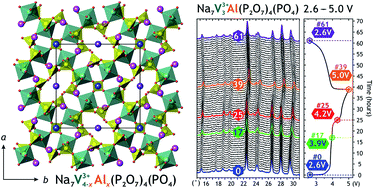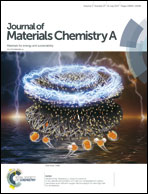Structural and electrochemical studies of novel Na7V3Al(P2O7)4(PO4) and Na7V2Al2(P2O7)4(PO4) high-voltage cathode materials for Na-ion batteries†
Abstract
A series of Na7V4−x3+Alx(P2O7)4(PO4) (x = 0, 1, 2, and 4) materials were synthesized by flux crystal growth. Novel Na7V4−xAlx(P2O7)4(PO4) (x = 1 and 2) compositions were structurally characterized by single crystal and powder X-ray diffraction analyses using laboratory and high-resolution synchrotron X-ray sources. The investigation of the electrochemical behavior of two new mixed V/Al phases as positive electrodes in Na-based batteries was performed using charge–discharge galvanostatic tests and operando X-ray diffraction experiments. It is demonstrated that the substitution of a part of vanadium with aluminum in Na7V4(P2O7)4(PO4) significantly increases the gravimetric capacity of these materials: from 70.9 mA h g−1 to 113.1 mA h g−1 and from 48.1 mA h g−1 to 92.7 mA h g−1 in Na7V3Al(P2O7)4(PO4) and Na7V2A2l(P2O7)4(PO4), respectively thanks to the activation of the V4+/V5+ redox couple. Different degrees of reversibility of the electrochemical reactions operating on the V3+/V4+ and V4+/V5+ redox couples in Na7V3Al(P2O7)4(PO4) are discussed from the analysis of operando X-ray diffraction.



 Please wait while we load your content...
Please wait while we load your content...